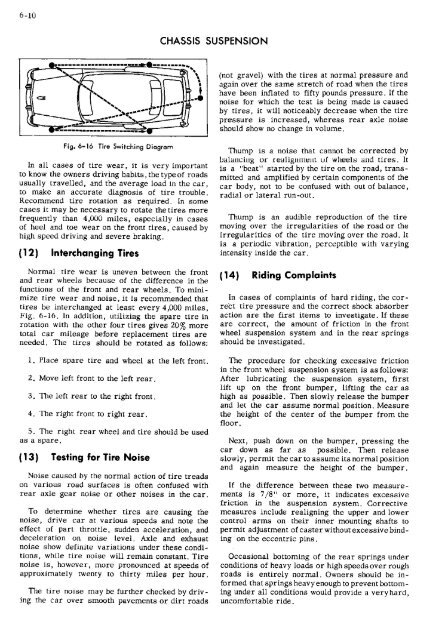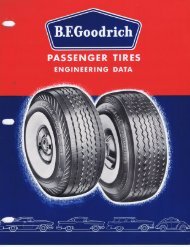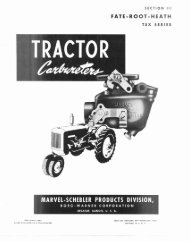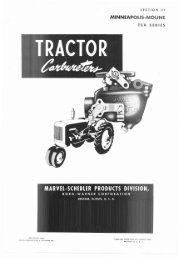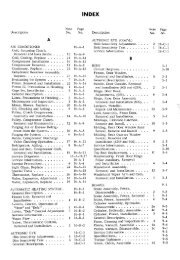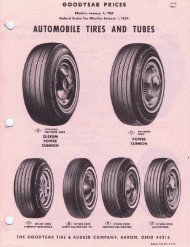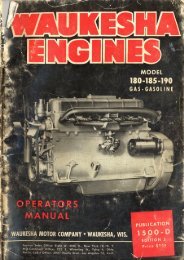pdf version - The Old Car Manual Project
pdf version - The Old Car Manual Project
pdf version - The Old Car Manual Project
You also want an ePaper? Increase the reach of your titles
YUMPU automatically turns print PDFs into web optimized ePapers that Google loves.
CHASSIS SUSPENSION<br />
not gravel with the tires at normal pressure and<br />
again over the same stretch of road when the tires<br />
have been inflated to fifty pounds pressure. If the<br />
noise for which the test is being made is caused<br />
by tires, it will noticeably decrease when the tire<br />
pressure is increased, whereas rear axle noise<br />
should show no change in volume.<br />
Fig, 6-16<br />
Tire Switching Diagram<br />
In all cases of tire wear, it is very important<br />
to know the owners driving habits, the type of roads<br />
usually travelled, and the average load in the car,<br />
to make an accurate diagnosis of tire trouble.<br />
Recommend tire rotation as required. In some<br />
cases it may be necessary to rotate the tires more<br />
frequently than 4,000 miles, especially in cases<br />
of heel and toe wear on the front tires, caused by<br />
high speed driving and severe braking.<br />
12 Interchanging Tires<br />
Normal tire wear is uneven between the front<br />
and rear wheels because of the difference in the<br />
functions of the front and rear wheels. To mini<br />
mize tire wear and noise, it is recommended that<br />
tires be interchanged at least every 4,000 miles,<br />
Pig. 6-16. In addition, utilizing the spare tire in<br />
rotation with the other four tires gives 20% more<br />
total car mileage before replacement tires are<br />
needed. <strong>The</strong> tires should be rotated as follows:<br />
1. Place spare tire and wheel at the left front.<br />
2. Move left front to the left rear.<br />
3, <strong>The</strong> left rear to the right front.<br />
4. <strong>The</strong> right front to right rear.<br />
5. <strong>The</strong> right rear wheel and tire should be used<br />
as a spare.<br />
13 Testing for Tire Noise<br />
Noise caused by the normal action of tire treads<br />
on various road surfaces is often confused with<br />
rear axle gear noise or other noises in the car.<br />
To determine whether tires are causing the<br />
noise, drive car at various speeds and note the<br />
effect of part throttle, sudden acceleration, and<br />
deceleration on noise level. Axle and exhaust<br />
noise show definite variations under these condi<br />
tions, while tire noise will remain constant. Tire<br />
noise is, however, more pronounced at speeds of<br />
approximately twenty to thirty miles per hour.<br />
<strong>The</strong> tire noise may be further checked by driv -<br />
ing the car over smooth pavements or dirt roads<br />
Thump is a noise that cannot be corrected by<br />
balancing 01 realignment of wheels and tires. It<br />
is a ‘beat’ started by the tire on the road, trans<br />
mitted and amplified by certain components of the<br />
car body, not to be confused with out of balance,<br />
radial or lateral run-out.<br />
Thump is an audible reproduction of the tire<br />
moving over the irregularities of the road or the<br />
irregularities of the tire moving over the road. It<br />
is a periodic vibration, perceptible with varying<br />
intensity inside the car.<br />
14 Riding Complaints<br />
In cases of complaints of hard riding, the cor<br />
r6ct tire pressure and the correct shock absorber<br />
action are the first items to investigate. If these<br />
are correct, the amount of friction in the front<br />
wheel suspension system and in the rear springs<br />
should be investigated.<br />
<strong>The</strong> procedure for checking excessive friction<br />
in the front wheel suspension system is as follows:<br />
After lubricating the suspension system, first<br />
lift up on the front bumper, lifting the car as<br />
high as possible. <strong>The</strong>n slowly release the bumper<br />
and let the car assume normal position. Measure<br />
the height of the center of the bumper from the<br />
floor,<br />
Next, push down on the bumper, pressing the<br />
car down as far as possible. <strong>The</strong>n release<br />
slowly, permit the car to assume its normal position<br />
and again measure the height of the bumper.<br />
If the difference between these two measure<br />
ments is 7/8" or more, it indicates excessive<br />
friction in the suspension system. Corrective<br />
measures include realigning the upper and lower<br />
control arms on their inner mounting shafts to<br />
permit adjustment of caster without excessive bind<br />
ing on the eccentric pins.<br />
Occasional bottoming of the rear springs under<br />
conditions of heavy loads or high speeds over rough<br />
roads is entirely normal. Owners should be in<br />
formed that springs heavy enough to prevent bottom<br />
ing under all conditions would provide a very hard,<br />
uncomfortable ride.


